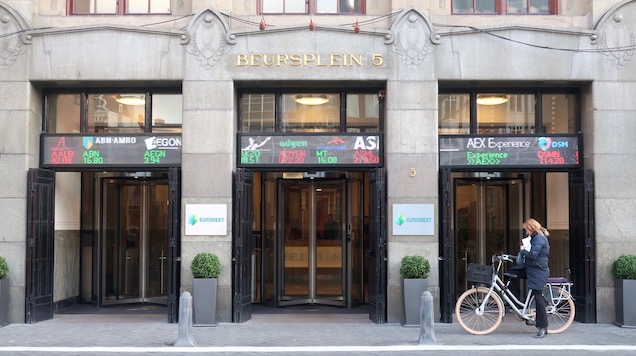
Amsterdam Stock Exchange
Amsterdam Stock Exchange
The Amsterdam Stock Exchange (also known as the AEX) is located on Beursplein 5 – in the historical city centre. The back of the building is located on the Warmoesstraat, city’s oldest street – in the Wallen area, which is also known as the Red Light District.

The Amsterdam Stock Exchange as it is today, located on Beursplein 5.
What does the abbreviation AEX mean?
The Amsterdam Exchange Index, or AEX, is a stock market index that tracks the performance of the leading companies traded on the Amsterdam Stock Exchange. It is a market capitalization-weighted index, meaning that the larger companies have a greater impact on the index. The AEX was first introduced in 1983 and is one of the oldest stock market indices in Europe. It is also one of the most widely-followed Dutch economic indicators. In recent years, the AEX has been one of the best performing stock market indices in Europe, thanks to the strong performance of the Dutch economy.
Amsterdam Exchange Opening Hours
The Amsterdam Stock Exchange is open from 9 am till 5.30 pm on weekdays. It is one of the oldest stock exchanges in the world, and it is home to many large Dutch companies such as Royal Dutch Shell, Unilever, and ING Group. The Amsterdam Stock Exchange is a popular destination for foreign investors, and it is one of the most important stock exchanges in Europe.
World’s First Stock Market
The Amsterdam Stock Exchange is considered to be the oldest, still in operation stock exchange in the world. It was founded in 1602, along with the incorporation of the Duch East India Company (VOC). Amsterdam Stock Exchange is more than 420 years old.
Geschichte

The Amsterdam Stock Exchange building on the right.
Amsterdam’s First Regular Traders’ Market
The city’s first regular traders’ market was located near the harbour, in the Warmoesstraat. A document dating from 1493 describes the north side of this street as a place where ‘traders meet every day’. There was no actual market building at that time. During the second half of the 16th century, the traders’ market – still an open-air market – moved to the Nieuwe Brug (New Bridge) adjoining the IJ lage. In bad weather, traders would make use of the nearby St. Olofskapel (Olofs Chapel) and the Oude Kerk (Old Church). It was not until 1611 that they acquired an exchange building of their own.

During rainy days people traded inside Amsterdam’s Old Church (on the right).
Amsterdam’s First Trading Law
In 1592, Amsterdam’s city council passed the first by-law to ensure that market trading was conducted in an orderly fashion. The by-law laid down fixed trading hours, as well as a code of conduct. An ‘exchange clerk’ was given the task of ringing a bell to signal the start of trading. Any latecomers were fined. This tradition of using a sound signal to open trading remains in use today. The bell, however, has been replaced by a – now familiar – gong.

The Old Church in Amsterdam, the oldest building in the city.
Amsterdam Stock Exchange 1602
The Dutch East India Company (the VOC) was the first company in the world to issue shares to the public at large. This was the beginning of the worldwide trade in shares. Investors from all walks of life were invited to buy shares. In 1606, they were given depositary receipts for their investments; these are now regarded as being the first shares ever issued. It was revolutionary change. Investors could recuperate their money by selling their shares, however their investment still formed part of the company’s capital. The VOC managed to double money, literally.
The first stock issued by the VOC is actually the main plot device for the movie Ocean’s 12 (2004).
First Amsterdam Stock Exchange
Amsterdam’s first commodity exchange openend in 1611. When architect Hendrick de Keyser was commissioned to design the building, the city council instructed him not to worry about the cost. The exchange was built on the Southern side of Dam Square, over five arches stranding the city’s Rokin canal. Traders conducted their business in an open courtyard, enclosed by 42 numbered pillars.

The Hendrick de Keyser Exchange, world’s first stock exchange.
Which made it easy to find those how had been allowed a permanent pitch. Most of the trading involved commodities, with shares accounting for only a small proportion of business. For over 200 years, the Hendrick de Keyser Exchange remained the centre of trade in Amsterdam.
Obligations That Make A Payout To This Day
The roaring trade in VOC shares paved the way for others. More and more government bodies found their way to the public capital market. When a dike burst in 1624, the local water board Lekdijk Bovendams issued fixed-interest bonds to fund the repair work, a practice that was later to become commonplace. The debenture issued in 1624 is the oldest known perpetual bond in the world that still pays interest – 15 euros a year to be precise.
Tulip Bulb Mania Of 1634
The first tulips appeared in the Netherlands in around 1590. The exotic plant soon became all the rage, first among the nobility and later among the ordinary people, too. Tulip prices began to soar in 1634 and by 1637 buyers were paying 1200 guilders for a variety that had sold for 20 guilders the year before! The bubble burst in February 1637, when bulb prices tumbled to 5%, and in some cases to just 1% of former levels in a short space of time. ‘Tulip mania’ as it was called, was the first instance of mass speculation and mainly affected the towns of Haarlem and Alkmaar. Speculation of this nature was forbidden on the the Amsterdam Stock Exchange.

The Netherlands, tulip fields.
Nowadays Dutch tulips are also traded on several markets, like the Amsterdam Flower Market.
Share Trade Books
In 1688, the Portuguese Jewish writer Joseph de la Vega published the first ever book on the stock market. Entitled Confusion de Confusiones (‘Confusion of Confusions’), the book consists of conversations between a philosopher, a merchant and a shareholder, and paints a lively picture of the Amsterdam stock market. The 17th-century publication its just as relevant today, over 300 years later. The Financial Times rates it as one of the ‘ten best books ever written about the stock market’.

A backroom inside Amsterdam’s current stock exchange.
World’s First Investment Fund
An Amsterdam merchant-broker called Abraham van Ketwich set up the world’s first investment fund in 1774. Named Eendragt Maakt Mage (‘United we stand’), the fund enabled individual investors to reduce their risks by spreading their investments over a number of stocks. The fund invested more or less exclusively in foreign bonds.
Amsterdam Zocher Exchange
Following the closure in 1835 of the Hendrick de Keyser Exchange, which had fallen into disrepair, a second commodity exchange openend in 1845. The trade in securities was to become its principal activity, soon accounting for a larger volume of business than the commodities trade, traditionally its main activity. Situated on the spot currently occupied by the Bijenkorf department store, the building was designed by architect Jan Zocher. Like the old exchange, it had an open trading floor encircled by arcades and numbered pillars. The occupants were unhappy: traders moaned about the draughts and the lack of space.

The city’s coat of arms in the Amsterdam Stock Exchange.
Royal Dutch Shell
The second half of the 19th century was a period of economic boom. The Amsterdam Stock Exchange experienced a new Golden Age on the back of the industrial revolution. Between 1865 and 1900, the number of stocks listed on the exchange soared from 115 to 1000. One of the newcomers was the ‘Royal Dutch Company for the Option of Oil Wells’, As it was then called, which went public as soon as it was incorporated. Known today as Royal Dutch Shell, it is still a multinational with operations in all corners of the world and is the biggest stock on the Amsterdam Exchange.
Amsterdam Berlage Exchange

De Beurs van Berlage pictured in 1903 Amsterdam.
Security traders finally got a new exchange building. The first meeting about the construction of a building to replace Zocher’s unpopular exchange took place in 1867. It was followed by 30 years of discussion about the trader’s requirements for the new building. In the Berlage Exchange the securities traders, for the first time, had a trading floor of their own. Not that this put an end to the complaints: the building’s foundation shifted and the rapid growth of securities trading meant that the building was soon too small.
Beursplein 5
When talking with the city council on a bigger and better building to cater for the massive growth in the stock market proved unproductive, the stock traders decided in 1910 that they might as well build a new exchange of their own. So it was that in 1913, the Amsterdam Stock Exchange Association opened the first stock exchange of its own at Beursplein 5, designed by architect Jos Cuypers. Trading in the new building started early in 1914. The stock traders had the run of 1350 m2 of floor space – twice as much as they were used to.

Entrance to the current Amsterdam Stock Exchange at Beursplein 5.
Amsterdam Stock Exchange: Information & Innovation
Even at the time of the VOC investors were aware of the vital importance of acces to good, reliable and up-to-date information. People came to the exchange not just to do business but also – and perhaps even more importantly – to hear all the latest news.
The importance of information grew in line with the rising volume of the foreign investments in the 18th and the 19th centuries. With a view of giving all investors rapid acces to the same accurate information, the exchange soon took the lead in devising new thecniques for distribution of communication and information. Two of the Dutch daily newspapers (het Financieele Dagblad and NRC-handelsblad) have their origins in stock exchange publications and both the Zocher and Berlage exchanges, which followed the Keizer, accommodated post, telephone and telegraph offices.

Inside the fully digitised Amsterdam stock exchange.
Stock Market Technology
Beursplein 5 (Beurs van Berlage) recorded a first in 1920. Long before national radio services were started in The Netherlands, the stock exchange began to broadcast share price by wireless. The advent of ticker machines in 1931 led to and information explosion, with stock prices being posted on a rate publication on the main trading floor and simultaneously transmitted to subscribers all over the country.
Screen Trading

The stock market had already moved from a trading floor to computer screens in 1998, and the options trade followed suit in 2002. This meant the end of the open outcry system in which brokers shouted out their buying and selling prices on the floor. The striking of the gong at 5:30 pm on December 6 signalled the end of 400 years of physical trading in Amsterdam. The odd tear was shed as the exchange geared up for the future.
Amsterdam Stock Exchange Euronext
At noon on 22 September 2000, the Paris Bourse, the Amsterdam Exchanges and the Brussels Exchanges officially merged to form Euronext.

The merger followed logically from the adaption of the euro 1999 and the growing competition with digital trading platforms. It was a reluctant marriage, however, marking it as it did the end of a 400-year old national exchange in the Netherlands. The Lisbon exchange and London’s LIFFE exchange joined Euronext in 2002.
20x Amsterdam Stock Exchange Listed Companies
- ASML Holding
- Unilever
- Royal Dutch Shell
- Adyen
- RELX Group
- Philips
- Prosus
- ING Group NV
- DSM
- Ahold Delhaize
- Heineken
- Wolters Kluwer
- Akzo Nobel
- Arcelormittal SA
- Just Eat TakeAweay
- NN Group
- Unibail-Rodamco
- KPN Kon
- ASM International
- Randstad NV
(Source: AEX 1 December 2022)
How to buy Amsterdam stocks?
Amsterdam stocks can be a great investment for those looking to get involved in the stock market. Amsterdam is known for its strong financial sector, and Amsterdam stocks tend to be very stable. Amsterdam also has a variety of different stock options to choose from, so investors can find Amsterdam stocks that fit their specific goals and objectives.
When it comes to buying Amsterdam stocks, there are a few different options:
BUX is a popular website that allows investors to buy and sell Amsterdam stocks online. Amsterdam also has a number of different brokerages that can help investors with their purchase of Amsterdam stocks. Amsterdam also has a number of different stock options to choose from, so investors can find Amsterdam stocks that fit their specific goals and objectives.
The most popular trading app in The Netherlands is DEGIRO. It’s an online broker that was founded in 2013. It is headquartered in Amsterdam, Netherlands, and it has offices in 14 European countries. DEGIRO offers investors low-cost access to a wide range of financial markets. It charges low fees for trades, and it does not require a minimum account balance. DEGIRO is also available in multiple languages, which makes it accessible to a wider range of investors. In addition, DEGIRO offers a mobile app, which allows investors to trade on the go. The app is available for both Android and iOS devices. DEGIRO is a popular choice for online investors due to its low fees, accessibility, and mobile app.
What are the requirements and rules to list a stock on the amsterdam exchange?
Companies seeking to list their stock on the Amsterdam Stock Exchange must meet certain requirements:
- They must be based in the European Union or another country with which the Netherlands has a treaty.
- They must have been in business for at least three years and have a minimum market capitalization of € 50 million.
- They must commit to abide by Dutch law and regulations.
- They must have a minimum of 100 shareholders. companies that meet these requirements can then apply to have their stock listed on the Amsterdam Stock Exchange.
The exchange will then review the application and make a decision based on whether or not the company meets all of the listing criteria. Once a company’s stock is listed on the Amsterdam Stock Exchange, it will be subject to all of the rules and regulations governing trading on the exchange.
What happens when a company delisted from stock exchange?
When a company delists from a stock exchange, it often trades over-the-counter (OTC). However, this is not always the case and the company may still be publicly traded. A company may choose to delist for a variety of reasons, including financial difficulties or a merger or acquisition. In some cases, a company may be delisted due to poor performance or fraud. When a company is delisted, it can still trade OTC, but the shares are often less liquid and the price is more volatile. As a result, investors may be reluctant to hold the shares and the company may have difficulty raising capital. Delisted companies also tend to be less transparent than companies that are listed on an exchange, which can make it more difficult for investors to make informed decisions.
ALSO READ:
Amsterdam Red Light District History




